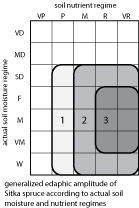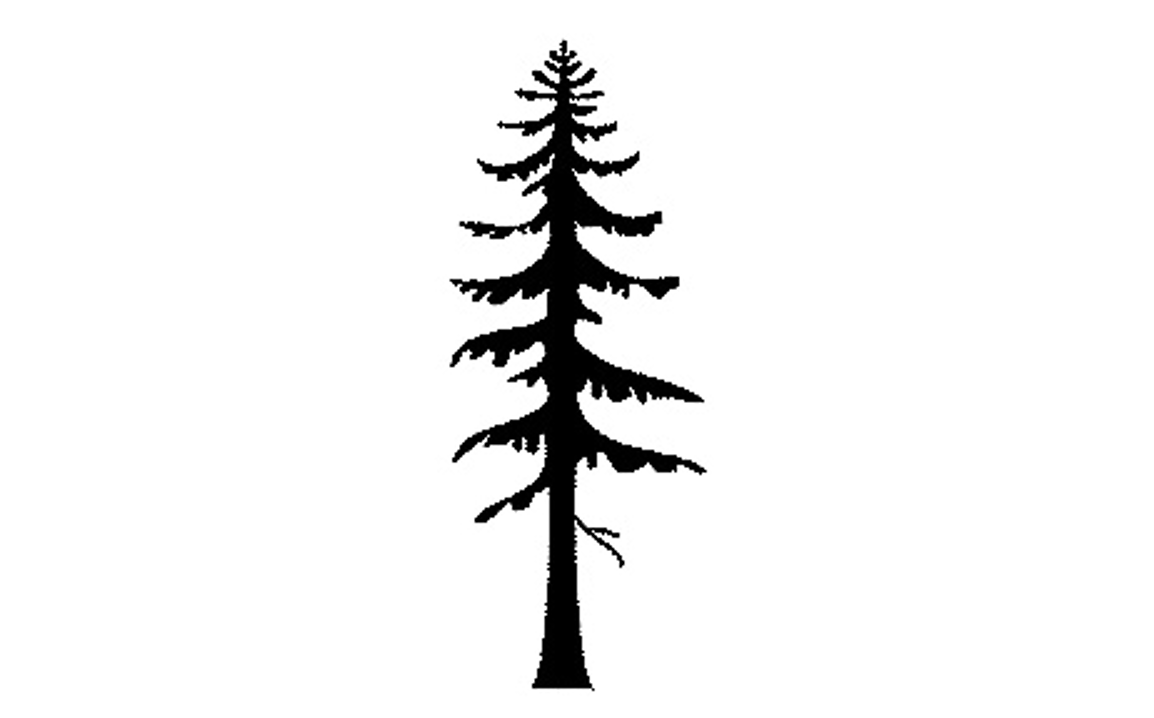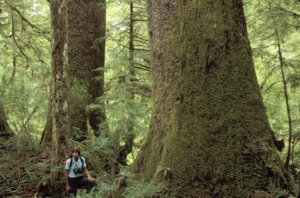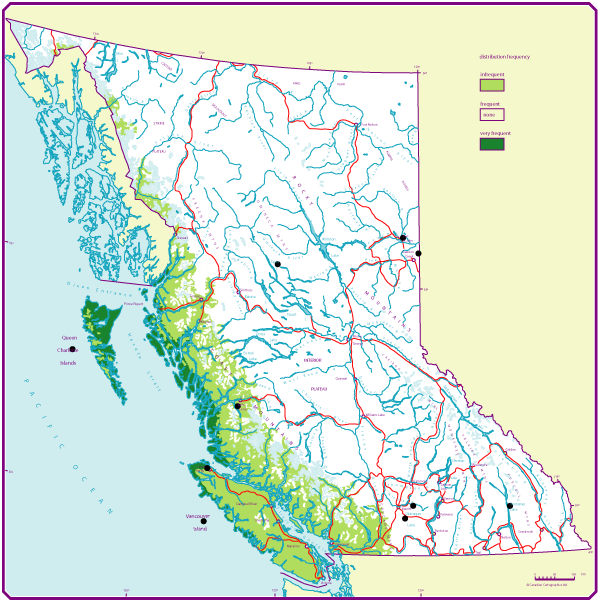Sitka spruce
On this page
- Geographic range and ecological amplitudes
- Tolerances and damaging agents
- Silvical characteristics
- Genetics and notes
Geographic range and ecological amplitudes
Description
Sitka spruce is the largest spruce in the world (reaching a height of 100m in, for instance, the Carmanah River Valley). At maturity it has a massive stem, often buttressed at base; relatively wide, compact crown, with horizontal branches, and a thin reddish-brown bark broken into large loose scales. Sitka spruce is a very productive, valuable timber species for lumber, pulp, and many other special uses.
Geographic range
Geographic element:
Western North American/mainly Pacific and less Cordilleran
Distribution in Western North America:
north, central and south in the Pacific region; (central) in the Cordilleran region
Ecological amplitudes
Climatic amplitude:
(subalpine boreal) – (cool temperate) – wet cool mesothermal
Orographic amplitude:
submontane – montane – (subalpine)
Occurrence in biogeoclimatic zones:
(lower MH), (northern subcontinental BWBS),(ICH), (CDF), wetter hypermaritime (maritime and submaritime) CWH
It has been stated that Sitka spruce is dependent on fog, commonly occurring in the Pacific coast fog belt. This association with fog may be important along the southern coast, but along the central and northern coast it is probably a coincidence, as the species may grow successfully outside this belt.
Edaphic amplitude

Range of soil moisture regimes:
slightly dry – fresh – moist – very moist – wet
Range of soil nutrient regimes:
(poor) – medium – rich – very rich; tolerant of salt spray and soils influenced by brackish water
The most productive growth of Sitka spruce occurs on moist and rich hypermaritime sites; therefore, it could be concluded from those field observations and experimental studies carried out by Krajina and his students (Cordes 1968, 1972; Krajina 1969) that Sitka spruce requires considerable amounts of both calcium and magnesium, possibly favoring magnesium. This is why it benefits (tolerates), to some degree, from calcium and magnesium inputs in brackish water or ocean spray. Sitka spruce also requires greater quantities of phosphorus than common douglas, western redcedar, or western hemlock. Ocean spray is a good external source of phosphorus.
Normally, calcium-rich soils provide a relatively favorable medium for nitrification, so it is rather surprising that Sitka spruce tolerates ammonium compounds when they replace nitrates and are the only source of nitrogen in the sand cultures. Nevertheless, in the complete Hoagland solution, applied in sand cultures, where nitrates prevail over ammonium compounds, Sitka spruce grows still better.
Sitka spruce tolerates sodium inputs from ocean spray or brackish water. Therefore, along the Pacific coast, where ocean spray has a strong influence on vegetation, pure stands of Sitka spruce may develop because other trees do not tolerate strong ocean spray. Another common name, tideland spruce, suggests this tolerance of salinity
Tolerance and damaging agents
Root system characteristics
Root habit of Sitka spruce is very variable- ranging from shallow, plate-like roots in the soils with a root-restricting layer to deep (up to 200cm), wide-spreading roots in the deep, well-aerated soils. Roots of Sitka spruce are associated with both ecto- and endo-mycorrhizae.
| Tolerance to | Tolerance class | Comments |
|---|---|---|
| low light | M | survives under hardwood (black cottonwood, red alder) overstories |
| frost | L | frost is unusual in hypermaritime climates |
| heat | L | extreme heat is unusual in hypermaritime climates |
| water deficit | L | absent on very dry and moderately dry sites |
| water surplus | H | grows on waterlogged sites and floodplains; tolerant of prolonged flooding and strongly fluctuating water table |
| nutrient (mainly N) deficiency | L | absent on very poor sites |
| Damaging agent | Resistance class | Comments |
|---|---|---|
| snow | L | absent or infrequent in snowy climates |
| wind | L | low resistance when exposed and in partially cut stands |
| Risk class | ||
|---|---|---|
| fire | L | not a major concern in hypermaritime climates |
| insect | H | white pine weevil and spruce beetle |
| fungi | L | root and butt rots (for example, Armillaria root disease and annosus root and butt rot) |
Associated tree species and successional role
In British Columbia, Sitka spruce grows in pure and mixed-species stands, which are prevailingly even-aged. Pure stands usually follow disturbance by wind, and occur on tidal flats, and on sites affected by ocean spray. Sitka spruce is present in early, mid-, and late stages of secondary succession along ocean shores, on floodplains and on upland sites; a major or minor component in old-growth stands in hypermaritime and maritime climates.
| Associated tree species |
Occurance class | Major area of occurance |
|---|---|---|
| western hemlock | H | the most common associate in hypermaritime climates |
| western redcedar | M | Hypermaritime climates |
| black cottonwood | M | high floodplain benches |
| red alder | M | hypermaritime climates and coastal floodplains |
| mountain hemlock | L | hypermaritime climates |
| alaska yellow-cedar | L | hypermaritime climates |
| white spruce (and hybrids) | L | northern and central coast-interior ecotone |
Genetics and notes
Genetics
Genetic variation in Sitka spruce is clinal, primarily along a latitudinal gradient. Sitka spruce may hybridize with white spruce (Picea x lutzii) (Roche 1969) and with Engelmann spruce. Such natural hybrids may be found in the Nass and Skeena River areas and along the coast-interior ecotone, respectively. Sitka spruce has very long branches, but the hybrids with Engelmann spruce have rather narrow crowns.
Notes
Sitka spruce is a desirable component in hypermaritime forests in pure or mixed-species stands, either with other conifers or hardwoods (nurse species in spruce weevil-prone areas), except on water and nutrient deficient-sites. The success of natural regeneration is often inconsistent, consequently planting is usually required if a high component of Sitka spruce is desired in new stands. More detailed silvics information is given by:
Harris, A.S. 1990. Picea sitchensis. Pp. 2260-267 in R.M. Burns and B.H. Honkala (technical coordinators) Silvics of North America, Vol. 1. Agri. Handbook 654, USDA For. Serv., Washington, D.C.

This is the general shape and outline of the Sitka spruce.

In the hypermaritime forest, Sitka spruce growth is far superior to other associated species. Sitka spruce is found on sites such as this alluvial terrace on western Vancouver Island.

